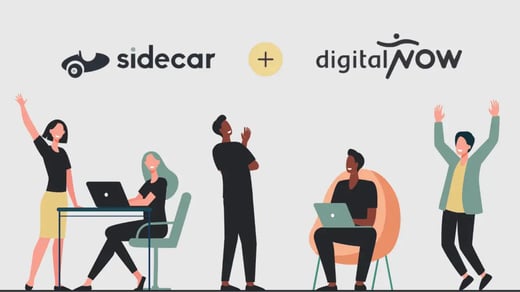By the time the coronavirus pandemic ground the world as we knew it to a halt in the spring of 2020, we were already deep into the planning stage of SURGE, our annual virtual conference for association professionals.
The event, which started a few years earlier as a biannual gathering of association pros discussing the latest ideas and technology to impact their market, has always been virtual. That’s why, while other organizations were scrambling to identify new strategies to move their in-person meetings online, we were focusing instead on driving registration and engagement.
Don’t get me wrong: That doesn’t mean we haven’t made our fair share of mistakes.
There was the time in 2019, for example, that in the early morning hours before SURGE went live, our chat provider pushed through an unknown-to-us update that resulted in audible “ping!” sounds every time someone made a comment, rendering the actual conversations almost unhearable.
But it’s those hard-earned lessons that mean we’ve learned a thing or two about how to produce flawless virtual events, whether it’s a webinar or a multi-day conference. That’s why we created this ultimate guide to virtual event production: We want to make sure you’ve got everything you need to create flawless virtual events of your own.
Why create a virtual event
While the pandemic and the social distancing mandates that came with it forced many organizations to transition to virtual events, there are plenty of reasons to keep the trend going.
For starters, virtual events allow attendees from all around the world to find and connect with your content — and each other. If someone can find your web page, then they can attend your event.
Plus, with quickly updating technologies that allow for closed captions at the rate of video production and new translation software, your potential audience is growing all of the time thanks to the increased accessibility of attending.
You no longer need to convince someone to register for, travel to and show up to your event: All they have to do is click a few buttons.
Plus, you can use virtual events for a variety of purposes.
Opportunities for virtual event production
Consider how you could turn these events into virtual experiences:
- Fundraisers
- Recruiting events and “open houses”
- Webinars, workshops and educational events
- Social gatherings and networking events
- Trade shows and exhibitions
- Internal meetings and gatherings
- Conferences and conventions
Potential cost savings
Virtual events are potentially huge money-savers — for you, and for your audience. Depending on the delivery platform you choose, the cost of simply offering a stage for your speakers can drop by thousands.
Just think about it: You could spend a few hundred dollars on a virtual event platform, or you could spend tens of thousands on renting an exhibit hall.
Even if you mail your attendees meal delivery gift cards or swag bags, there’s no way that’ll approach the cost of offering full food and beverage options.
Many speakers today also factor in the reduced cost of virtual in their appearance fees — you don’t have to pay to fly any keynotes in and put them up in hotels, for one thing — so it’s possible to secure speakers you may not otherwise have had the budget for in the context of a live event.
That often translates to lower ticket prices for your attendees, or even if you don’t drop your own prices, attendees will at least benefit from avoiding travel costs. And a lower barrier of entry means potential audience growth.
Growth and engagement opportunities
Last but not least, by hosting a virtual event, you’d be joining a huge trend in event production. Just look at 6Connex, a virtual event platform that saw business grow more than 1,000% by May 2020, according to Forbes. That’s more than 52,000 events — on one platform alone.
And Grand View Research projects virtual events will grow nearly ten-fold over the next decade from $78 billion to $774 billion.

With growth like that, you can bet that event management companies, SaaS platforms and other tech companies are rushing to create newer, cooler and more interesting ways to offer virtual events, all of which means you’ll have newer, cooler and more interesting ways to interact with and grow your audience.
Key differences between in-person and virtual event production
In the face of the pandemic’s swift cancelation of all events big and small, many organizations rushed to shift their in-person gatherings to virtual spaces.
But not all events are created equal, and that means any smart event manager will understand how to capitalize on the similarities and the differences between live and virtual events.
Here’s what you should be thinking about:
What’s the same:
Start with why
Before you hire a single speaker or explore where you’ll host your event, the first thing you need to think about are your goals.
What is it you’re hoping to achieve in creating your event? Do you need to get your association members access to continuing education credits? Do you want to offer networking opportunities to a group of young professionals? Are you just there to have a good time and provide an escape?
Regardless of any decisions that come later, why you’re hosting an event should be the North Star by which every choice is made.
People want to see people
It’s the nature of the beast. Your event is somehow, some way supposed to get people together.
Whether you’re offering networking opportunities so your association members can meet new people or you’re connecting attendees with the ideas offered by top-level keynote speakers, you need to create some chances for genuine engagement.
For the fun of it
Look, it doesn’t matter what topic it is your content needs to cover, you’ve got to make sure your attendees actually enjoy themselves.
Now, there’s a lot of leeway there (there’s a big difference between what an attendee at Coachella expects vs. what a professional association conference attendee expects), but the bottom line is that no one should be so bored they dread returning to your event.
What’s different:
This is no 1-to-1
The biggest mistake you can make is to think you should translate, verbatim, a live event onto a livescreen.
It’s simply not the same, and no one is going to make the mistake of thinking they are. Instead, you’ve got to build an experience for the stage you have, whether it’s live and in person or smaller and pixelated.
Time is of the essence
If you’re going to the trouble of buying a plane ticket, shifting your work schedule, spending a few nights in a hotel and paying top-dollar attendance fees, you can absolutely bet that I expect to be entertained all day long.
But if I’m attending your conference from the comfort of my desk chair while my kid asks for an extra juice box, you better know that my time is more valuable than ever.
Virtual events have to be designed for the time conscious and for the multi-taskers. That means bathroom breaks, shorter hours and a clear focus on how to keep me engaged in the content you’re delivering.
Also, you should consider time zones of your attendees when planning live content delivery. (If you’re on the East Coast, for example, you’ll alienate West Coasters with an 8 a.m. start time!)
Rethink sponsorship
While in the past, you may have been able to appease sponsors by making sure their corner of the exhibit hall got set up correctly, in a virtual world, it’s time to get creative.
When we’ve looked into sponsor needs in virtual events, we’ve found that sponsors still want authentic engagement experiences, so you’ve got to build that into your virtual platform model from the very beginning.
Maybe sponsors will have video intros for each conference session? Maybe you invite sponsors to take part in a live chat? Think beyond the virtual exhibit booth, and find ways to ensure your sponsors are providing value that attendees can connect with in real ways.
If you remember nothing else, remember this: You can not recreate an exceptional live event virtually. Instead, it is your job to create an exceptional virtual event.
How do I pick a virtual event platform?
Thanks to the rise in popularity of virtual events, there are more options than ever to choose from when it comes to selecting a platform for your event.
Once you have a firm understanding of the overall goal of your event, these are the key questions you should consider before selecting a platform:
- How many attendees do I expect to host?
- How many speakers do I expect to have?
- How long will my event be? Minutes, days, hours?
- Will my event require attendees to go and come back later, such as in the case of multi-day events?
- What portion of my content will be pre-recorded? Some, all or none?
- What kind of engagement opportunities will I need to offer my attendees?
- What kind of engagement opportunities will I need to offer my sponsors?
- Do I want or need my platform to handle registration?
- Do I want or need my platform to handle email invitations?
- Do I want or need my platform to host my video after the event?
- What kind of analytics will my platform need to host?
- Will I need to reply on my platform to provide proof of attendance, such as for continuing education credits?
- Does my platform need to provide a delivery space for static content, like PDFs, eBooks and other handouts?
- Do I need my platform to support attendee profiles and offline networking?
Once you’ve got a clear idea of all of how you’d answer all of these questions, it’s important to remember that few — if any! — platforms will be an exact right fit, so it’s possible that you may need to compromise on a feature or two.
That’s why the questions above are so valuable: If you can think through the things you absolutely can’t compromise on for the experience you need, then deciding on the platform you’d like to use becomes much easier when you’re not distracted by unnecessary bells and whistles.
So, what are the features you’ll actually need in your event platform?
That depends on how you answer the questions above, but here are some standard options we like to look out for because they help create a more well-rounded experience. What ends up being important in your event will depend on your own event goals.
Platform features to look for:
Engagement
- Live chat
- Poll questions
- Handout delivery
- Up-voting and down-voting questions
- Support for pre-recorded video and audio
- Emojis in the live chat
- Pop-up CTAs during presentations
- User profiles, including calendar syncing for attendees to meet offline
- Support for live streaming video from Zoom, YouTube, Vimeo or other platforms
Analytics
- Registration data: Names, emails, custom fields, UTM tracking
- Attendee data: Names, emails, custom fields, when someone logged in/out, browser
- Engagement data: Who interacts with what within the platform, like poll responses and live chat tracking
- Email opens and click-throughs
Marketing and sponsor needs
- Email messaging for invitations, go-live and published recordings
- UTM tracking
- Exhibitor booths and profiles
Regardless of what platform you choose, don’t be afraid to change things up by switching platforms. What works for your event today may not be the best choice three months from now.
Also, you may need to consider tools that can help create a cohesive and fully customized experience for your event.
For example, you may like the registration process offered by one platform but you want to deliver your live content through another, so it may be worth integrating the two using Zapier to ensure your registrants have a smooth experience.
Working with speakers to create virtual events
All the world’s a stage, and all the men and women merely speakers.
Shakespeare
OK, well, that’s not exactly what the Bard had in mind, but the advent of virtual events and the accessibility they offer really does create a world in which your options for speakers offer a longer list than ever.
Just think about it: A speaker who may not have traveled for your event in the past no longer has that excuse, and someone whose experience would be a great story to share with your audience but who suffers from stage fright might be willing to join your event if they can pre-record their presentation.
Plus, many high-dollar speakers who may have been impossible for your budget to accommodate in the past may be willing to offer you a discount because they can participate without ever leaving home.
Amazing, right?
But hold it right there: As you should know by now, creating an exceptional virtual event is not the same thing as creating an exceptional in-person event. And that means you’ve got to work with your speakers differently.
Renowned speaker and author David Meerman Scott compares the difference in preparing for virtual events and in-person events to the same difference an actor faces in preparing to film a TV show versus a play in front of a live audience.
“A great virtual event includes elements of live television, such as hosts (who might be located in a purpose-built studio), great guests, polished production pieces, audience interaction, networking, and so much more."
from “Standout Virtual Events,” a book Scott wrote with Michelle Manafy.
That means when picking a speaker for your virtual event, you have to consider how good they are on camera: Not every actor was made for the stage, and not every actor was made for TV!
Even if you’ve seen a speaker present before, it’s a best practice to search YouTube for filmed presentations they’ve made, and make sure the experience translates well for your audience.
You’ll also want to prepare your speakers in advance of your virtual event to make sure they’re as ready for your audience as possible.
Here’s a list of things to communicate with your speakers, whether they’re professional speakers or not:
#1 Mind the background
Even if there’s little chance they’ll end up on RoomRater, you want to make sure your speakers aren’t creating distractions before they’ve even spoken up.
Ask your speakers to avoid back-lit windows, busy rooms, recording on phones, bad internet connections and virtual backgrounds.
Do ask your speakers to find a quiet space, wear simple colors and patterns, and utilize upgraded cameras and microphones when possible.
#2 Make it engaging
Even if your speakers are pre-recording their content, there are tons of great ways to engage with an audience, like offering suggestions of ideas to drop in a live chat or changing up their presentation by avoiding “death by Powerpoint.”
(And if they do need slides, try not to rely on them the whole time; even a quick, full-screen intro and outro of a speaker’s face will help create real connections!)
#3 Give them the details
Even if you’re using a platform as simple and as widely used as Zoom, you’ll avoid any potential pitfalls by offering all of the details ahead of time.
We like to use a standard handout that offers a screenshot of what to expect on event day, including notes about what they should and shouldn’t worry about in engaging with the platform.
When possible, it’s also a great idea to offer a trial run or to log on early so your speaker has a few minutes to get acclimated to your platform.
And no matter what, offer a cell phone number so your speaker can get in touch with someone who can walk them through any missteps on event day.
Drive engagement
You would never invite friends to a party at your house and then fail to turn on the stereo, lay out some snacks and put a few drinks in the fridge.
The exact same thing is true of a virtual event: You’ve got to set the stage for everyone to have a good time, even if it’s just a couple bottles of water and a bag or two of tortilla chips.
OK, enough with the analogy. Here’s what you should know:
49% of marketers say that audience engagement in virtual events is the biggest factor in having a successful event, according to Markletic, but only 30% of organizers actually send their attendees any giveaways, and only about 30% of marketers even use polling to keep their attendees’ attention.
Plus, Wild Apricot found that organizations that didn’t try to engage virtual attendees were 150% more likely to have an unsuccessful event.
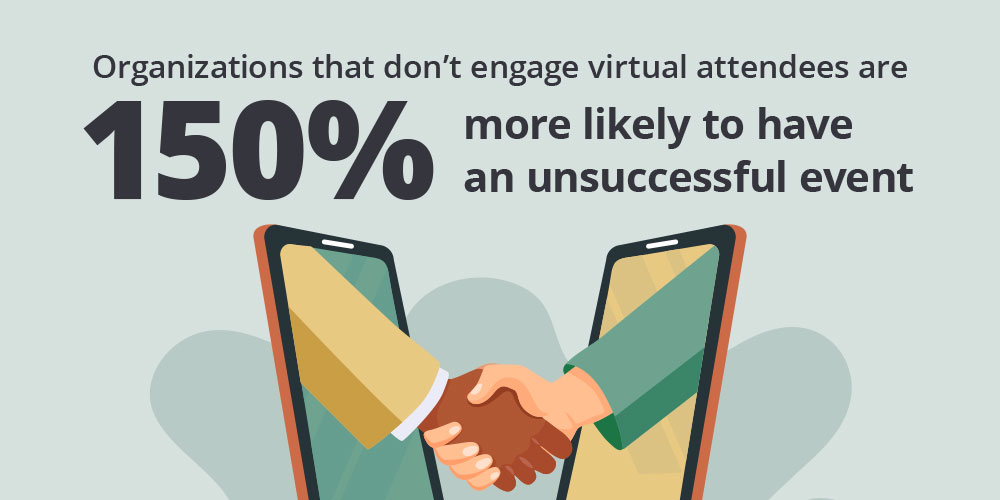
What’s the big takeaway? You’ve got a lot to gain — and a lot to lose — if you’re not working to drive virtual event engagement!
How to make your virtual events engaging
Here’s how to make your virtual events and conferences as engaging as possible.
Tip #1 - Lean into the platform
Even the most basic of platforms offer some opportunities to get drive engagement.
In Zoom, for example, you’ve got breakout rooms and the ability to chat with your attendees.
In larger platforms like eWebinar and Big Marker, the engagement tools get more fancy. Either way, make sure your audience is able to use what’s at their fingertips.
Tip #2 Keep the chat going
Live chats offer the most consistent ways to engage with your audience.
An attendee may be able to rewatch an event later, but they’ll likely never be able to get back in the room with the same cohort to have the same conversation again.
Have your team prep questions to drive the conversation forward, and encourage respondents with organic reactions.
Tip #3 Listen to the data
Offer surveys, like an NPS, to find out what is and isn’t working for your audience, and then react accordingly.
Make sure your audience knows that you’re there to listen to their feedback — and let that feedback drive your decisions. It’ll help your audience know they’re part of making the event great, too.
Tip #4 Use social media
If you were hosting a live event, chances are you’d post about it on Facebook, encourage attendees to share a Twitter hashtag and perhaps even hop into a Clubhouse “after party” to talk about what everyone learned.
This is one spot where your virtual event should be no different!
In fact, almost 75% of event planners consider social media the most effective tool for marketing events, according to EventMB, with 58% of marketers using social media before, during and after an event.
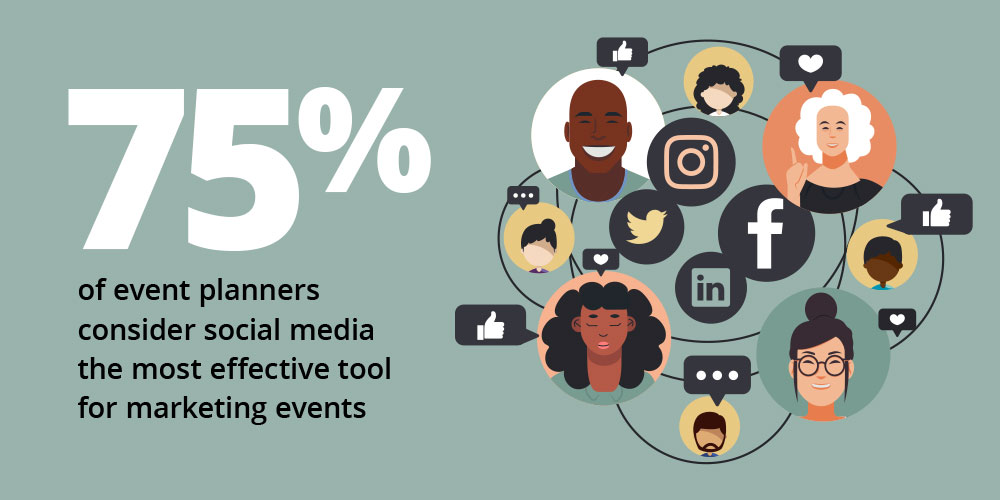
Tip #5 Beyond Zoom happy hour
Consider adding some surprising content, like a cocktail demo during virtual networking, guided meditation to kick off a long day, or even a live music performance during a lunch break.
There are also a variety of ways you can gamify your virtual events to kick engagement up a notch and encourage connection and friendly competition. It can be as easy as including some trivia, bingo, or even a fun “virtual scavenger hunt.”
After all, your event is supposed to be a shared experience, so make it a real experience.
Tip #6 Go the extra mile
Just because your audience isn’t coming to you doesn’t mean you can’t go to your audience.
Translation? Mail! Lean on the old USPS to ship out coffee mugs, sponsor swag, tote bags, keynote speakers’ books, toys to help keep kids distracted — whatever!
Don’t forget to include a note asking that your attendees share their swag on social media, too.
Remember: It’s important to create a marketing plan that’ll get your audience excited about your event before, during and after it takes place.
As virtual events have become more popular, event platforms have reported lower attendance rates. Wild Apricot reports that average attendance of virtual events is about 45% of registered attendees.
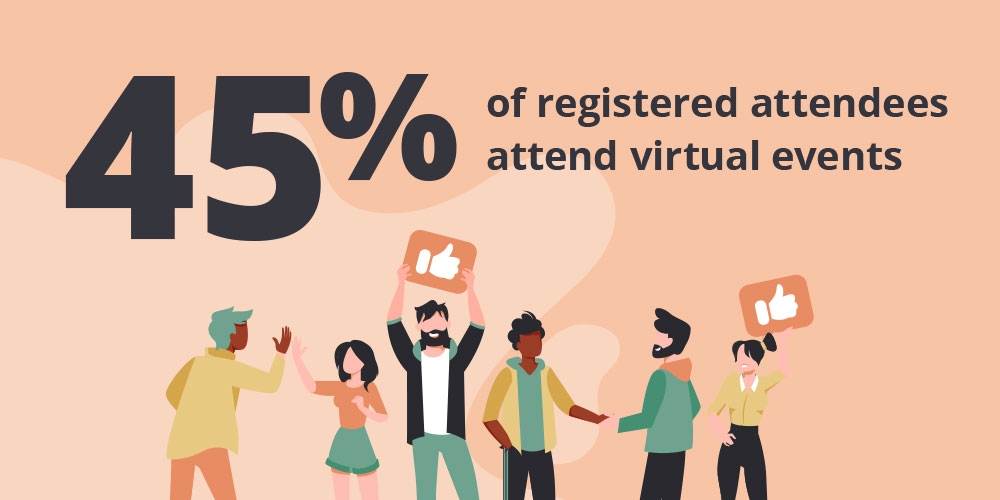
Still, you want to drive registration as much as possible.
Why?
Because collecting email addresses and contact info for potential members and customers, who you’ve already identified as being interested in the work you’re putting together, has tremendous value.
Plus, wouldn’t you rather have 50% of 1,000 people show up than 50% of 100 people?
Pre-recorded vs. live virtual events
Virtual events offer a ton of options in production. Why? Because you’re no longer confined to getting a speaker onstage!
That means you’ve got a handful of options to weigh when you’re putting together your virtual event.
Here, we’ll look at a few of the pros and cons to consider when you’re deciding whether to pre-record or offer your virtual event live.
Pre-recorded events
Pros:
- No surprises here! You know exactly what your video looks like before you’ve got a single attendee logged on.
- You can get fancy. It’s a heck of a lot easier to include B-roll, cutaways, high-quality graphics and bottom-thirds (those are the fancy name titles on the bottom of your screen) when you have the benefit of editing in advance of an event.
- Your speakers can join any live chat, and they won’t be distracted while filming.
- It’s easier to schedule and secure busy speakers if they can film their presentation anytime before your event.
Cons:
- Things change! Imagine filming a virtual event before the pandemic closed everything down, and then airing it afterward. Your entire presentation could become outdated.
- Some attendees like to feel like a speaker is responding directly to their reactions in the live chat, but that’s not possible with a pre-recorded presentation.
Live events
Pros:
- Who doesn’t love a little surprise? There’s something undeniably immediate about an event in which anything could happen.
- Many speakers tend to prefer them because they’re able to ask audience questions and genuinely react to the answers.
- One and done! It’s a heck of a lot faster not to have to worry about too much pre-production and video review.
Cons:
- Well, anything can happen! In our own events, we’ve had speakers whose video didn’t work (even though it did in test rounds), barking dogs, Internet connection issues and even unexpected visitors popping into the video screen.
- Your speakers might get distracted by the live chat. Some people love it, some people hate it.
- It’s a little harder to make live events look well-produced thanks to the inevitable technical hiccups that can come with screen-sharing and apps for adding names and titles.
The cost to produce a virtual event
Producing a virtual event is far from free, and just like a live event, the cost of putting one together can vary widely based on how highly produced your event ends up being.
One of the things to consider first is the platform usage fees. In many cases, the cost of the platform you use will go up and down depending on the number of attendees you have, and the level of service you require in plotting out your event.
In some multi-day conferences, for example, platform fees include white glove onboarding where your team is responsible for turning over the basic details and videos, and the platform team does the rest.
That kind of service, however, can easily start to climb into the tens of thousands.
On the other hand, simpler, self-service platforms can cost far less, but the work your team puts in to making the experience seamless will likely increase.
Here’s a checklist of fees to consider when budgeting your virtual event:
- Platform usage fees:
- Will these fees increase if we have more registrants?
- Will these fees continue if the platform hosts our video content for a long period of time?
- Will these fees include services that would save us money or time elsewhere?
- Speaker fees
- Video editing and music rights
- Marketing videos
- Intros and outros
- Video edits for pre-recorded videos
- Video edits for archiving the video for usage later
- Production costs
- Studio fees
- Audio/visual equipment
- Marketing materials
- Graphic design for any handouts
- Swag bags, including postage
How to price a virtual event
While the cost to put together a virtual event may drop considerably, it’s rarely — if ever — free to actually produce. So, how much should you charge your attendees for showing up?
If you’re using in-person events as your benchmark, Michael Tatonetti, the founder of Pricing for Associations, recommends pricing virtual events between 50% and 80% of what you’d charge for in-person attendance.
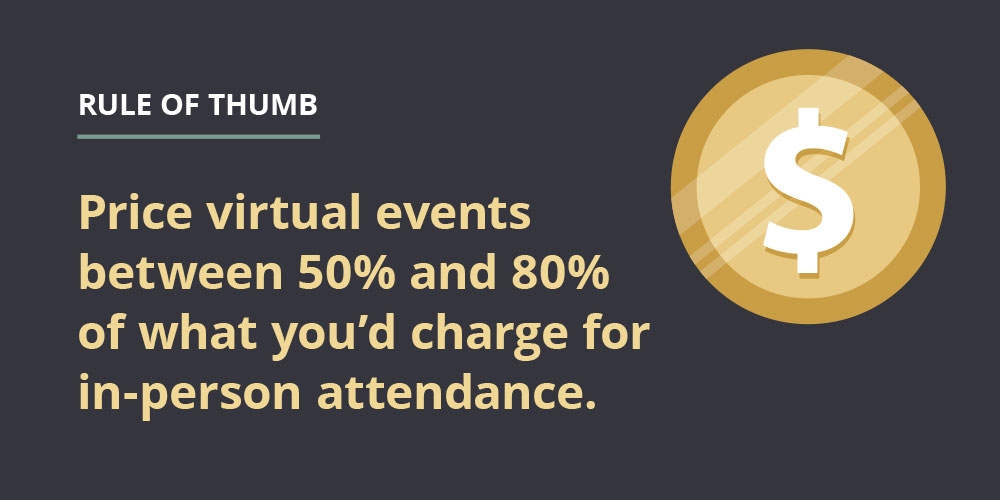
That allows your audience to see that you’ve recognized that your own costs may have dropped in producing the event, but it also indicates that attendees should still expect close to if not the same (or more!) value from attending.
For example, an attendee at a live event may have access to 20 different sessions over the course of a single day, but when they’re on-site, they may only be able to attend four or five sessions.
But in a virtual conference, they might be able to still catch four or five sessions, and may even have access to all 20 recordings. Even if they’re not getting any exhibit hall conference breaks, you’ve got to admit: That attendee might get even more value from a virtual event.
Now, what if you don’t have the live event to use as a benchmark? Consider this: Bizzabo, which offers its own virtual platform, has reported that 80% of virtual event registrations are free. That makes for a pretty tough market!
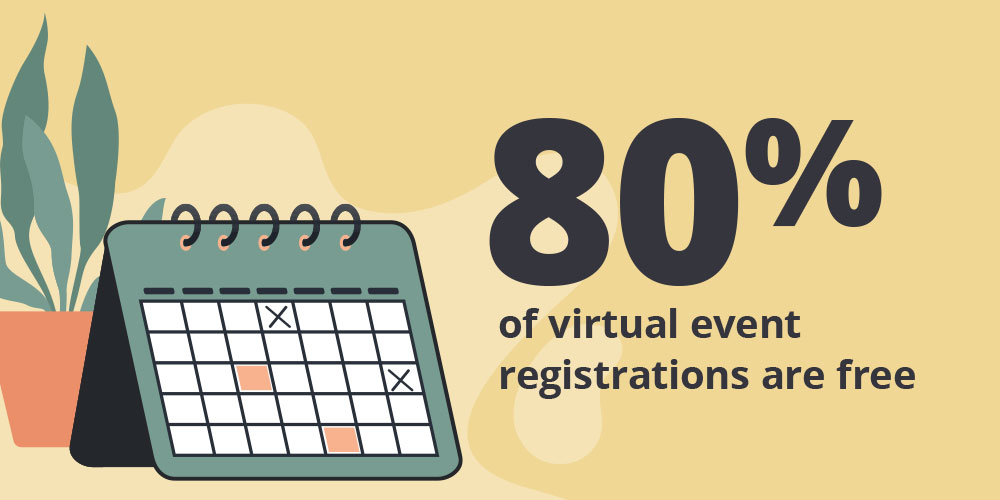
But, Bizzabo reported, in the events that do require paid attendance, attendees were typically looking at average ticket prices of over $440 in the second half of 2020.
The future is hybrid
When we consider the future of virtual events, the only thing we know is nothing is certain.
The fun part, though, is getting to figure it out.
Today, we’re hearing a lot about “hybrid events,” which combine live, in-person events with virtual capabilities. Maybe the next time you host a big conference, you’ll be able to double or triple attendance by including an at-home audience by live-streaming your content.
The most important thing to remember is that engagement is what will keep your attendees coming back, year after year, so even if your format changes, your focus should always be on how to create the most engaging, compelling event that plays on your audience's desire not to miss out on the epic, amazing event you’ll be producing.
What changes are you going to make to your next virtual event? And do you have a plan for moving to hybrid? Check out our article on hybrid events and why you should plan ahead here:

April 29, 2021


